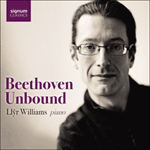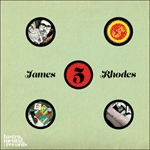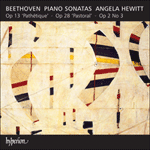
Welcome to Hyperion Records, a British classical label devoted to presenting high-quality recordings of music of all styles and from all periods from the twelfth century to the twenty-first.
Hyperion offers both CDs, and downloads in a number of formats. The site is also available in several languages.
Please use the dropdown buttons to set your preferred options, or use the checkbox to accept the defaults.


Following the reiterated unaccompanied bass note of its initial bar, the first harmony presented in the Op 28 sonata is a discord leaning away from the tonic, as though the piece were starting in mid-stream. Beethoven reintroduces the drum-taps of his beginning in a coda which has them receding into the distance, to bring the piece to a pianissimo close with scraps of the main melody floating above the bass-line.
Beethoven’s second subject is no less smooth and seamless than the first, and perhaps for this reason he also brings into play a more disjunct closing theme—a syncopated melodic line above a staccato accompaniment in imitation of horns. In view of the generally amiable nature of the exposition, the development section is altogether darker and more dramatic. It unfolds throughout in the minor, concentrating on a fragment of the principal subject with ever greater intensity, until eventually the music comes to rest on a long drawn out chord. At this point, Beethoven interpolates, as if from afar, and in a distant key, a fragmentary version of the closing subject, first in the major, and then—following a pause—in the minor.
The slow movement, in the minor, is like some processional march. As he so often liked to do, Beethoven has its melody given out legato by the right hand, above a staccato accompaniment in the left. The theme’s second half, featuring an obstinately repeated pungent dissonance, unfolds over a repeated pedal-note which recalls the reiterated bass of the opening movement. Following the more rustic-sounding middle section in the major, Beethoven writes his reprise in the form of a variation; but there is also a coda which reintroduces the middle section’s sharply defined rhythm, while at the same time reaching a climax on the same dissonance featured in the second half of the movement’s march-like opening theme. The closing bars introduce a sighing two-note figure surmounted by a deeply expressive turn-like phrase which brings the piece to an end in an atmosphere of deep nostalgia.
Following the scherzo, the final rondo returns to the pastoral charm of the sonata’s opening movement. Not that Beethoven could ever write a large-scale piece of this kind entirely devoid of tension: its central episode is a piece of closely worked counterpoint based on a ‘winding’ chromatic subject, and it reaches a climax of considerable force before the rondo theme returns in all its innocent simplicity. Moreover, rather than allow the movement to sink to a resigned close, as he had done in the opening Allegro, Beethoven adds a ‘presto’ coda in the form of a variation on the rondo theme, to bring the sonata to a dizzying conclusion.
from notes by Misha Donat © 2018
 Beethoven: Beethoven Unbound Beethoven: Beethoven UnboundA comprehensive new cycle of the Beethoven sonatas recorded live at London's Wigmore Hall during the pianist's epic fourth rendition of these masterpieces .» More |
 James Rhodes 5 James Rhodes 5Five years on from his debut recording, James Rhodes has firmly established himself in the classical world as a pioneering figure—reaching out through concerts, recordings and television documentaries to create new classical music fans whilst rema ...» More |
 Beethoven: Piano Sonatas Opp 2/3, 13 & 28 Beethoven: Piano Sonatas Opp 2/3, 13 & 28 |

